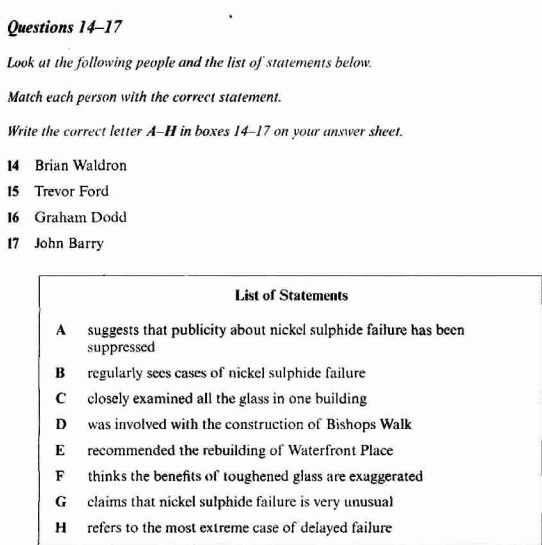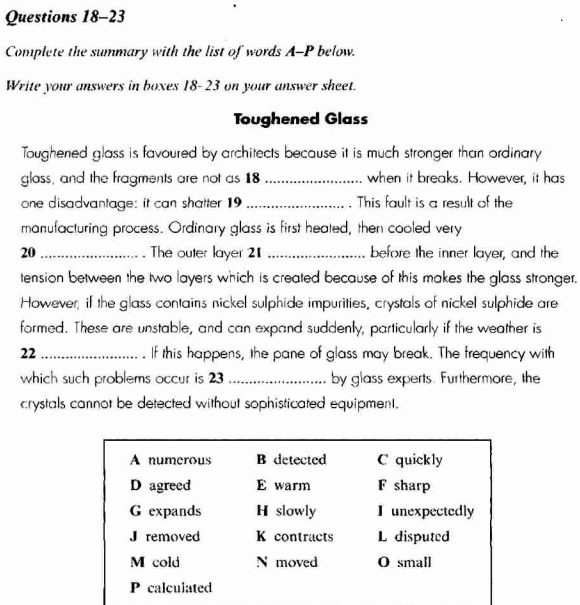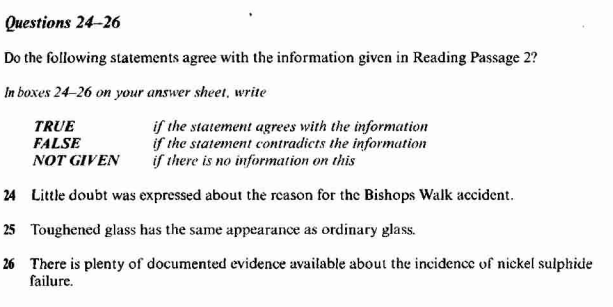剑桥雅思5:Test4雅思阅读PASSAGE 2真题+答案+解析
发布时间:2020-10-29 关键词:剑桥雅思5:Test4雅思阅读PASSAGE 2真题+答案+解析为帮助同学们学习,小编为大家整理了剑桥雅思5:Test4雅思阅读PASSAGE 2真题+答案+解析,希望能够对大家有帮助。关于剑桥雅思的资讯关注新航道北京学校剑桥雅思栏目。
READING PASSAGE 2
You should spend ubou 20 minutes on Questions 14 -26, which ure based on Reuding Passage 2belo.
Flawed Beauty: the problem with toughened glass
On 2nd August 1999, a particularly hot dayin the town of Cirencester in the UK, a largepane of toughened glass in the roofof a
shopping centre at Bishops Walk shatteredwithout warning and fell from its frame.
When fragments were analysed by expertsat the giant glass manufacturer Pilkington,which had made the pane, they found thatminute crystals of nickel sulphide trappedinside the glass had almost cer tainly causedthe failure.
'The giass industry is aware of the issue,'says Brian Waldron, chairman of the
standards committee at the Glass andGlazing Federation, a British trade
association, and standards developmentofficer at Pilkington. But he insists that
cases are few and far between, 'It's a veryrare phenomenon,' he says.
Others disagree. 'On average I see aboutone or two buildings a month suffering fromnickel sulphide related failures," says BarrieJosie, a consultant engineer involved in theBishops Waik investigation. Other expertstell of similar experiences. Tony Wilmott ofLondon based consulting engineers
Sandberg, and Simon Armstrong at CladTechAssociates in Hampshire both say they knowof hundreds of cases. 'What you hear is onlythe tip of the iceberg," says Trevor Ford, aglass expert at Resolve Engineering inBrisbane. Queensland, He believes the
reason is simple: 'No-one wants bad press.'
Toughened glass is found everywhere, fromcars and bus shelters to the windows, wallsand roofs of thousands of buildings aroundthe worid. lt's easy to see why. This glasshas five times the strength of standardglass, and when it does break it shattersInto tiny cubes rather than large, razor-sharpshards. Architects love it because large
panels can be bolted together to make
transparent walls, and turning it into ceilingsand floors is almost as easy.
It is made by heating a sheet of ordinaryglass to about 620C to soften it slightly,alowing its structure to expand, and thencooling it rapidly with jets of cold air. Thiscauses the outer layer of the pane to
contract and solidify before the interior.
When the interior finally solidifies and
shrinks, it exerts a pull on the outer layerthat leaves it in permanent compressionand produces a tensile force inside the
glass. As cracks propagate best in materialsunder tension, the compressive force on thesur face must be overcome before the panewill break, making it more resistant to
cracking.
The problem starts when glass contains
nickel sulphide impurities. Trace amounts ofnickel and sulphur are usually present in theraw materials used to make glass, and
nickel can also be introduced by fragmentsof nickel alloys falling into the molten glass.As the glass is heated, these atoms react to
form tiny crystals of nickel sulphide. Just atenth of a gram of nickel in the furnace cancreate up to 50,000 crystals.
These crystals can exist in two forms: a
dense form called the alpha phase, which isstable at high temperatures, and a less
dense form called the beta phase, which isstable at room temperatures. The high
temperatures used in the toughening
process convert all the crystals to the
dense, compact alpha form. But the
subsequent cooling is so rapid that thecrystals don't have time to change back tothe beta phase. This leaves unstable alphacrystals in the glass, primed like a coiledspring, ready to revert to the beta phasewithout warning.
When this happens, the crystals expand byup to 4%, And if they are within the central,tensile region of the pane, the stresses thisunleashes can shatter the whole sheet. Thetime that elapses before failure occurs isunpredictable. It could happen just monthsafter manufacture, or decades later,
although if the glass is heated - by
sunlight, for example - the process is
speeded up. ironically, says Graham Dodd,of consulting engineers Arup in London, theoldest pane of toughened glass known tohave failed due to nickel sulphide inclusionswas in Pilkington's glass research buildingin Lathom, Lancashire. The pane was
27 years old.
Data showing the scale of the nickel
sulphide problem is almost impossible to
find. The picture is made more complicatedby the fact that these crystals occur in
batches. So even if, on average, there isonly one inclusion in 7 tonnes of glass, ifyou experience one nickel suiphide failurein your building, that probably means
you've got a problem in more than onepane. Josie says that in the last decadehe has worked on over 15 buildings withthe number of failures into double figures.One of the worst examples of this is
Waterfront Place, which was completed in1990. Over the following decade the 40-storey Brisbane block suffered a rash of
failures. Eighty panes of its toughened glassshattered due to inclusions before expertswere finally called in, John Barry, an expertin nickel sulphide contamination at the
University of Queensland, analysed everyglass pane in the building. Using a studiocamera, a photographer went up in a cradleto take photos of every pane. These werescanned under a modified microfiche readerfor signs of nickel sulphide crystals. 'Wediscovered at least another 120 panes withpotentialy dangerous inclusions which werethen replaced,' says Barry. 'It was a veryexpensive and time -consuming process thattook around six months to complete.'
Though the project cost A$1.6 million (nearlyf700,000), the alternative - re cladding theentire building - would have cost ten timesas much.
READING PASSAGE 2翻译
你应该花20分钟回答问题14 -26,这是基于第二段的。
美丽的缺陷:钢化玻璃的问题
1999年8月2日,在英国的塞伦塞斯特,一个特别炎热的日子里,一幢建筑物的屋顶上出现了一块巨大的钢化玻璃
主教步行街的购物中心在毫无预警的情况下倒塌。
当制造这块玻璃的大型玻璃制造商皮尔金顿的对碎片进行分析时,他们发现,镶嵌在玻璃表面的微小硫化镍晶体几乎肯定是导致破裂的原因。
协会主席沃德隆(Brian Waldron)说,giass行业已经意识到了这个问题
玻璃和玻璃联合会标准委员会,一个英国行业
协会,皮尔金顿标准开发办公室。但他坚持认为
他说,这是一种罕见的现象。
其他人不同意。巴里乔西(BarrieJosie)是参与韦克主教案调查的顾问工程师,他说:“我平均每个月看到一到两栋建筑发生与硫化物有关的事故。”其他也说过类似的经历。Tony Wilmott就职于伦敦咨询工程师公司
桑德伯格和汉普郡CladTechAssociates的西蒙•阿姆斯特朗(Simon Armstrong)都表示,他们知道数百起这样的案例。“你听到的只是冰山一角,”布里斯班Resolve Engineering的aglass特雷弗•福特(Trevor Ford)说。昆士兰,他相信
原因很简单:“没人想要负面报道。”
钢化玻璃随处可见,从汽车候车亭到窗户、墙壁和世界各地成千上万建筑物的屋顶。原因很简单。这种玻璃的强度是普通玻璃的五倍,当它打碎时,它会碎成小方块,而不是像剃刀一样锋利的大碎片。建筑师喜欢它是因为它很大
面板可以用螺栓固定在一起制成
透明的墙壁,把它变成天花板和地板几乎同样容易。
它的制作方法是将一块普通玻璃加热至约620摄氏度,使其稍微软化,使其结构膨胀,然后用冷空气迅速冷却。这将导致窗格的外层
在内部之前收缩和凝固。
当内部最终凝固
当它收缩时,外层会产生引力,使外层处于压缩状态,并在外层产生张力
玻璃。由于裂缝在受拉情况下在材料中传播得,所以在面板破裂之前必须克服面板上的压力,使其更能抵抗
破解。
问题开始于玻璃包含
硫化镍杂质。痕量的镍和硫通常存在于制造玻璃的材料中
镍也可以通过镍合金碎片落入熔融玻璃中而引入。玻璃受热时,这些原子起反应
形成微小的硫化镍晶体。在熔炉中仅仅1 / 10克镍就能制造出多达5万个晶体。
这些晶体可以以两种形式存在
致密的形式被称为相,它在高温下是稳定的,在高温下是不稳定的
致密的形式称为贝塔相,在室温下是稳定的。高
用于增韧的温度
过程将所有晶体转换为
致密的,紧的形式。但是,
随后的冷却速度是如此之快,以至于结晶没有时间回到beta阶段。这样就会在玻璃中留下不稳定的睫状体,就像卷曲的弹簧一样,随时准备在没有任何警告的情况下恢复到测试阶段。
当这种情况发生时,晶体会膨胀高达4%,如果它们位于玻璃的中央受拉区域,释放的压力会将整片玻璃碎裂。失败之前的时间是无法预测的。可能是在生产几个月后,也可能是几十年后,
虽然如果玻璃加热-被
比如阳光,这个过程就是
加速。具有讽刺意味的是,伦敦奥雅纳咨询工程公司的格雷厄姆•多德说,已知最古老的钢化玻璃因含硫化镍而失效,这一事故发生在位于兰开夏郡Lathom的皮尔金顿玻璃研究大楼。面板是
27岁。
显示镍的刻度的数据
硫化物问题几乎是不可能解决的
找到。由于这些晶体存在于大气中,这一事实使情况更加复杂
批次。所以,即使7吨玻璃中平均只有一层,但如果你的建筑中出现了一层镍的破裂,那也可能意味着
你的问题不止在一个盒子里。乔西说,在过去的十年里,他工作过超过15栋建筑,失败的数量达到两位数。最糟糕的例子是
于1990年落成的海旁地方。在接下来的十年里,这座40层楼高的布里斯班大楼经历了一场暴风雨
失败。80块钢化玻璃在最终请来之前由于夹杂物而破碎,乔



Question 14
答案: G
关键词: Brain Waldron
定位原文: 原文第2段末句: “But he insists that…”
解题思路: 原文:“这是罕见的现象。”BrianWaldron说。因此答案为选项G。
Question 15
答案:A
关键词: Trevor Ford
定位原文: 原文第3段最后两句 “What you hear is only the…He believes the reason…”
解题思路: 原文:“公众所知道的只不过是冰山一角罢了。”昆士兰州布里斯班市Resolve工程公司的玻璃Trevor Ford说道。他认为原因很简单:“没人想要坏新闻。”因此答案为选项A。
Question 16
答案:H
关键词: Graham Dodd
定位原文: 原文第8段倒数第2句: “Ironically, says Graham Dodd…”
解题思路: 原文:Graham Dodd,伦敦Arup顾问建筑师说,“具有讽刺意味的是,因为含有硫化镍而导致破裂的‘历史最悠久’的钢化玻璃是兰开夏郡拉苏的Pilkington公司的玻璃研究大厦的玻璃,使用时间是27年。” 因此答案为选项H。
Question 17
答案:C
关键词: John Barry
定位原文: 原文末段第4句: “John Barry, an expert in nickel sulphide…”
解题思路: 原文:昆士兰大学的硫化镍Barry分析了大厦所有的钢化玻璃。因此答案为选项C。
Question 18
答案: F
关键词: break
定位原文: 原文第4段第3句: “This glass has five times…”
解题思路: 原文:“钢化玻璃的强度是普通玻璃的5倍,破碎时裂成细小颗粒而不是锋利(razor-sharp)的大块碎片。”因此答案为选项F。
剑桥雅思5阅读解析Test4答案+详细的解题思路指导
Question 19
答案:I
关键词: shatter
定位原文: 原文第8段第3句: “The time that elapses before failure…”
解题思路: 原文:“破裂时间无法预测(unpredictable)……”因此答案为选项I。
Question 20
答案:C
关键词: Heated, cooled
定位原文: 原文第5段第1句: “It is made by heating…”
解题思路: “钢化玻璃由普通玻璃制成:把一块普通玻璃加热到大约620摄氏度,使之轻度软化、结构膨胀,然后用冷气流迅速(rapidly)将其冷却。”因此答案为选项C。
Question 21
答案:K
关键词: out layer, inner layer
定位原文: 原文第5段第2句: “This causes the outer layer…”
解题思路: 原文:“这导致玻璃的外层先于内部收缩(contract)和凝固。”因此答案为选项K。
Question 22
答案: E
关键词: expand suddenly
定位原文: 原文第8段第4句: “It could happen just months after…”
解题思路: 原文:“尽管玻璃被日光(heated)会加快晶体的转化速度。”因此答案为选项E。
Question 23
答案:L
关键词: glass experts
定位原文: 原文第2段末句: “It’s a very rare phenomenon…” 及第3段第1句: “Others disagree.”
解题思路: 原文中Brian Waldmn宣称这是罕见的现象,而其他人如Barrie Josie等则持否定意见,由此可见对于问题发生的几率有争议,因此答案为选项L。
Question 24
答案:TRUE
关键词: doubt, Bishops Walk
定位原文: 原文首段最后1句: “When fragments were analysed by experts…”
解题思路: 题目:关于主教街的购物中心的事故原因几乎没有疑问
原文:“经过分析,几乎确^次亊故是由玻璃内部硫化镍的微型晶体引起的。”因此答案为TRUE。
剑桥雅思5阅读解析Test4答案+详细的解题思路指导
Question 25
答案:NOT GIVEN
关键词: ordinary glass
定位原文: 无
解题思路: 题目:钢化玻璃和普通玻璃外观相同。原文中没有出现相对应的比较。因此答案为NOT GIVEN。
Question 26
答案: FALSE
关键词: documented evidence, nickel sulphide failure
定位原文: 原文倒数第2段首句: “Data showing the scale…”
解题思路: 题目:关干硫化镍问题可以找到充足的可考证的证据。原文:“能够表明硫化镍问题的规模的数据几乎无法找到。”因此答案为FALSE。




